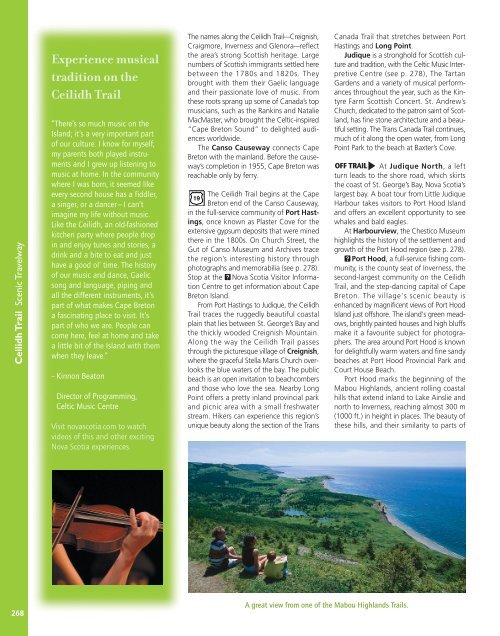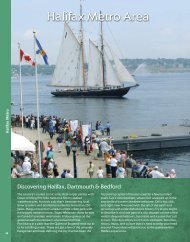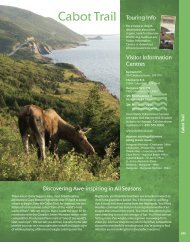You also want an ePaper? Increase the reach of your titles
YUMPU automatically turns print PDFs into web optimized ePapers that Google loves.
Ceilidh Trail Scenic Travelway<br />
Experience musical<br />
tradition on the<br />
Ceilidh Trail<br />
“There’s so much music on the<br />
Island; it’s a very important part<br />
of our culture. I know for myself,<br />
my parents both played instruments<br />
and I grew up listening to<br />
music at home. In the community<br />
where I was born, it seemed like<br />
every second house has a fiddler,<br />
a singer, or a dancer—I can’t<br />
imagine my life without music.<br />
Like the Ceilidh, an old-fashioned<br />
kitchen party where people drop<br />
in and enjoy tunes and stories, a<br />
drink and a bite to eat and just<br />
have a good ol’ time. The history<br />
of our music and dance, Gaelic<br />
song and language, piping and<br />
all the different instruments, it’s<br />
part of what makes Cape Breton<br />
a fascinating place to visit. It’s<br />
part of who we are. People can<br />
come here, feel at home and take<br />
a little bit of the Island with them<br />
when they leave.”<br />
– Kinnon Beaton<br />
Director of Programming,<br />
Celtic Music Centre<br />
Visit novascotia.com to watch<br />
videos of this and other exciting<br />
<strong>Nova</strong> <strong>Scotia</strong> experiences.<br />
The names along the Ceilidh Trail—Creignish,<br />
Craigmore, Inverness and Glenora—reflect<br />
the area’s strong Scottish heritage. Large<br />
numbers of Scottish immigrants settled here<br />
between the 1780s and 1820s. They<br />
brought with them their Gaelic language<br />
and their passionate love of music. From<br />
these roots sprang up some of Canada’s top<br />
musicians, such as the Rankins and Natalie<br />
MacMaster, who brought the Celtic-inspired<br />
“Cape Breton Sound” to delighted audiences<br />
worldwide.<br />
The Canso Causeway connects Cape<br />
Breton with the mainland. Before the causeway’s<br />
completion in 1955, Cape Breton was<br />
reachable only by ferry.<br />
The Ceilidh Trail begins at the Cape<br />
19<br />
Breton end of the Canso Causeway,<br />
in the full-service community of Port Hastings,<br />
once known as Plaster Cove for the<br />
extensive gypsum deposits that were mined<br />
there in the 1800s. On Church Street, the<br />
Gut of Canso Museum and Archives trace<br />
the region’s interesting history through<br />
photographs and memorabilia (see p. 278).<br />
Stop at the ¥<strong>Nova</strong> <strong>Scotia</strong> Visitor Information<br />
Centre to get information about Cape<br />
Breton Island.<br />
From Port Hastings to Judique, the Ceilidh<br />
Trail traces the ruggedly beautiful coastal<br />
plain that lies between St. George’s Bay and<br />
the thickly wooded Creignish Mountain.<br />
Along the way the Ceilidh Trail passes<br />
through the picturesque village of Creignish,<br />
where the graceful Stella Maris Church overlooks<br />
the blue waters of the bay. The public<br />
beach is an open invitation to beachcombers<br />
and those who love the sea. Nearby Long<br />
Point offers a pretty inland provincial park<br />
and picnic area with a small freshwater<br />
stream. Hikers can experience this region’s<br />
unique beauty along the section of the Trans<br />
Canada Trail that stretches between Port<br />
Hastings and Long Point.<br />
Judique is a stronghold for Scottish culture<br />
and tradition, with the Celtic Music Interpretive<br />
Centre (see p. 278), The Tartan<br />
Gardens and a variety of musical performances<br />
throughout the year, such as the Kintyre<br />
Farm Scottish Concert. St. Andrew’s<br />
Church, dedicated to the patron saint of Scotland,<br />
has fine stone architecture and a beautiful<br />
setting. The Trans Canada Trail continues,<br />
much of it along the open water, from Long<br />
Point Park to the beach at Baxter’s Cove.<br />
At Judique North, a left<br />
turn leads to the shore road, which skirts<br />
the coast of St. George’s Bay, <strong>Nova</strong> <strong>Scotia</strong>’s<br />
largest bay. A boat tour from Little Judique<br />
Harbour takes visitors to Port Hood Island<br />
and offers an excellent opportunity to see<br />
whales and bald eagles.<br />
At Harbourview, the Chestico Museum<br />
highlights the history of the settlement and<br />
growth of the Port Hood region (see p. 278).<br />
¥Port Hood, a full-service fishing community,<br />
is the county seat of Inverness, the<br />
second-largest community on the Ceilidh<br />
Trail, and the step-dancing capital of Cape<br />
Breton. The village's scenic beauty is<br />
enhanced by magnificent views of Port Hood<br />
Island just offshore. The island's green meadows,<br />
brightly painted houses and high bluffs<br />
make it a favourite subject for photographers.<br />
The area around Port Hood is known<br />
for delightfully warm waters and fine sandy<br />
beaches at Port Hood Provincial Park and<br />
Court House Beach.<br />
Port Hood marks the beginning of the<br />
Mabou Highlands, ancient rolling coastal<br />
hills that extend inland to Lake Ainslie and<br />
north to Inverness, reaching almost 300 m<br />
(1000 ft.) in height in places. The beauty of<br />
these hills, and their similarity to parts of<br />
268<br />
A great view from one of the Mabou Highlands Trails.
















